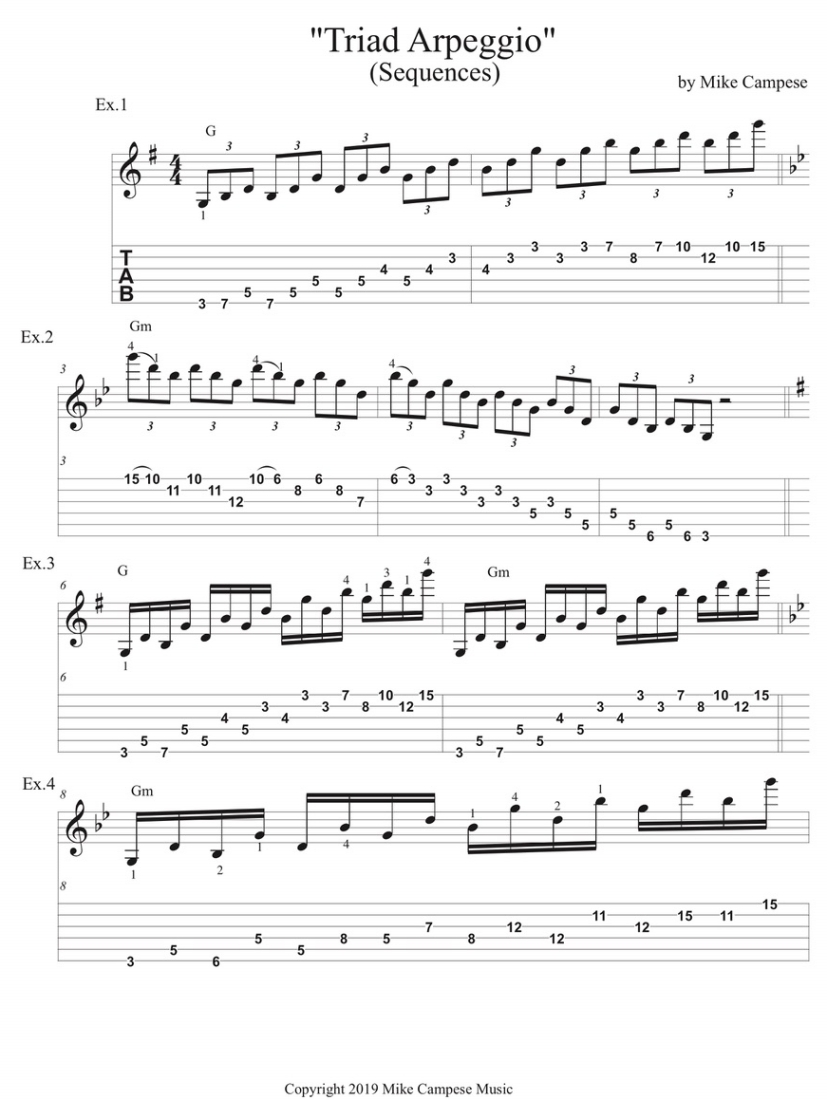Welcome back! In this lesson I would like to show you some ways you can make your arpeggios sound more interesting, instead of running up and down them and just playing the notes in order.
The use of arpeggio sequences is a great way to make them sound more unique and they great for building your technique.
For this lesson we will be focusing on triad arpeggios (3-note chords), and if you are not sure what an arpeggio is, it is a broken chord. I have covered arpeggios and some sequential patterns in previous lessons. Also, all of these examples are played using alternate picking. Now let’s expand the concept.
Example 1 is a 3-note sequential pattern that moves up a G major arpeggio (G, B, D), in triplets. This is a very common sequence that you will see used in scales a lot and it sounds great applied to arpeggios. Each note begins with each inversion of the triad and since it is a triad, there will be 3 different inversions. Of course, this works with any arpeggio, be sure to apply it to all the basic triads first, and then the sevenths as well.
MP3 - Triad Arpeggio Sequences - Example 1
Example 2 is based on the G minor (G, Bb, D) arpeggio inversions. Most of it is played on three strings, except the last couple pf bars; it moves down a 6-string, Gm arpeggio. This is a great way you can apply the 3-note sequence and this works on any set of strings. For example, string sets 2, 3, 4 - 3, 4, 5 - and the others as well.
MP3 - Triad Arpeggio Sequences - Example 2
Example 3 is a really cool arpeggio sequence that marches through the basic triads. I call this is an up - down type sequence. To play this sequence, you play the first note, skip the second note, play the third note and then come back down to the second note. For example, G, D, B, G, D, B etc and this same pattern continues throughout the arpeggio. If you don’t know these basic triad arpeggios, it would be very beneficial to learn the formulas and the notes in each one all over the neck. I won’t get too much into the theory, I have covered triads in previous lessons you may want to check out. We just did G major and G minor, apply this to all of the other triad arpeggios.
MP3 - Triad Arpeggio Sequences - Example 3 - G
MP3 - Triad Arpeggio Sequences - Example 3 - G minor
Example 4 is the same G minor arpeggio as the previous example with the up and down sequence, but we are moving up the neck. This is a little tricky to finger and it sounds really cool at higher speeds. You may hear this type of thing in classical music a lot.
MP3 - Triad Arpeggio Sequences - Example 4

That is it for now! Be sure to make up your own arpeggio sequences. Also, don’t forget to visit www.mikecampese.com for more details and to order CDs/Merch.
Mike Campese is an all-around music performer, session artist and teacher competent in many musical styles, electric and acoustic. He has studied at G.I.T. (Honors Graduate), and with Paul Gilbert, Norman Brown, Stanley Jordan, Scott Henderson and Keith Wyatt.